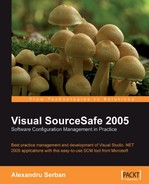Book Description
"Best practice management and development of Visual Studio .NET 2005 applications with this easy-to-use SCM tool from Microsoft
SCM fundamentals and strategies clearly explained
Real-world SOA example: a hotel reservation system
SourceSafe best practices across the complete lifecycle
Multiple versions, service packs and product updates.
In Detail
Why is Software Configuration Management important?
Software Configuration Management (SCM) is the discipline of managing the building and modification of software through techniques including source-code control, revision control, object-build tracking, and release construction. SCM involves identifying the configuration of the software at given points in time, systematically controlling changes to the configuration, and maintaining the integrity and traceability of the configuration throughout the software development lifecycle.
Software Configuration Management is one of the first skills a serious developer should master, after becoming proficient with his or her development tools of choice. Unfortunately, this does not always happen because the subject of SCM is not commonly taught in either academic or company training.
When developing software, you need to have a manageable team development effort, track and maintain the history of your projects, sustain parallel development on multiple product versions, fix bugs, and release service packs while further developing the application. This is where the concepts of Software Configuration Management come into play; SCM is about getting the job done safer, faster, and better.
Visual SourceSafe has a long history behind it. The previous versions were either loved for their ease of use and integration with other Microsoft products, or hated because the headaches caused by using them improperly. This book will help you to avoid such problems.
This book uses a real-world case-study project to teach you how to manage software configuration efficiently using Visual SourceSafe 2005, Microsoft’s Software Configuration Management (SCM) solution for independent developers and for developers working in small- and medium-sized teams. It also provides a best-practices reference on using SourceSafe 2005 to manage the software development lifecycle.
"Table of Contents
- Visual SourceSafe 2005 Software Configuration Management in Practice
- Visual SourceSafe 2005 Software Configuration Management in Practice
- Credits
- About the Author
- About the Reviewers
- Preface
- 1. Controlling the Evolution of Software Products
- 2. The SourceSafe 2005 Architecture
- 3. Creating a Service-Oriented Application
- Specifications—Project Architecture
- Designing the System
- Summary
- 4. Adding Solutions to the SourceSafe Database
- 5. Developing Solutions under Source Control
- Setting up the Workspace
- Adding New Project Files
- Checking In to the Database
- Versions and History
- Getting the Latest Versions
- Team Cooperation
- The Exclusive Check-Out Model
- Comparing Versions
- Undoing Version Changes
- The Multiple Check-Out Model
- Pinning Files
- Searching for Files in the Database
- Sharing Files
- Moving Projects and Files
- Deleting, Recovering, and Purging Files
- Summary
- 6. Working from Remote Locations
- Working Online
- Working Offline
- Reconnecting to the Database
- Using the LAN Plug-In
- Using the Internet Plug-In
- Summary
- 7. Managing the Software Development Lifecycle
- A. Installing Visual SourceSafe 2005
- B. Creating and Configuring SourceSafe Databases
- C. Database Maintenance
